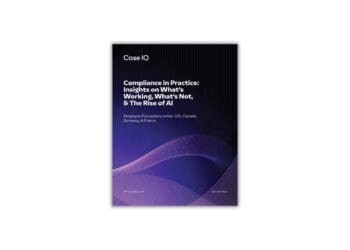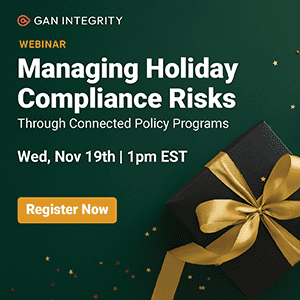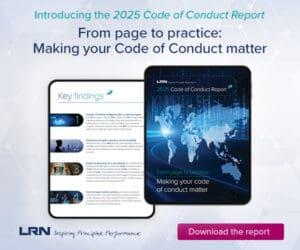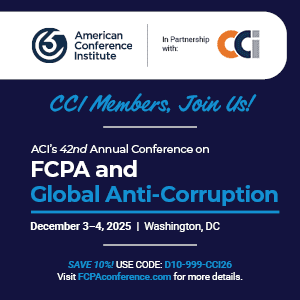Evidence of an illicit relationship between coworkers went super-viral this summer, culminating in two people (a CEO and his company’s HR director) leaving their jobs after being shown on a kisscam at a concert. Of course, not all cases of corporate conflicts of interest are as salacious and immediately compelling as Coldplay-gate, but as Steph Holmes of EQS Group explores, that doesn’t make them any less perilous for organizations, which risk reputation damage, internal turmoil and even legal consequences in the wake of ethical blunders.
Conflicts of interest are among the most persistent challenges in corporate governance and compliance today. They often emerge quietly: a casual favor, an undisclosed role, a moment of poor judgment. Yet in the age of real-time media and viral visibility, even seemingly small lapses can trigger immediate consequences, especially when they play out in the court of public opinion.
The compliance risks tied to conflicts of interest aren’t limited to policy violations or legal exposure. They include something more unpredictable: public perception. A single image, comment or moment can rapidly undermine trust, escalate scrutiny and force an organization into damage control before any formal investigation even begins.
Consider the recent example at a Coldplay concert, where a kisscam captured an unexpectedly intimate exchange between the CEO of Astronomer and the company’s chief people officer. The clip quickly went viral, prompting public discussion about the nature of their relationship and what it might signal about corporate culture and power dynamics.
This story offers a pointed reminder for compliance professionals: When personal interests intersect with professional responsibilities, the perception of bias can be just as damaging as the reality. Public perception can coalesce rapidly, and companies must manage conflicts of interest proactively. As regulatory expectations grow and stakeholder scrutiny intensifies, how companies resolve conflicts of interest has become a defining marker of leadership trust and governance maturity.
What constitutes a conflict of interest?
At its core, a conflict of interest arises when personal interests — financial, relational or otherwise — have the potential to interfere with professional responsibilities. These situations don’t always involve wrongdoing. But they introduce a risk that decisions could be biased or that they might appear to be.
Often, discussions of conflicts of interest focus narrowly on romantic relationships or familial ties. In reality, the spectrum is broader. Common examples include:
- Accepting substantial gifts or hospitality from vendors or clients.
- Favoring specific organizations or vendors due to personal relationships.
- Holding financial stakes in suppliers, partners or competitors.
- Serving on external boards that could influence decision-making.
- Operating a side-business that overlaps with one’s professional role.
What these cases share is not necessarily illegal or noncompliant behavior but the risk that objectivity could be compromised or appear to be compromised. And when that risk involves individuals in key decision-making positions, the stakes multiply.
Unchecked, these situations can lead to mistrust within teams, regulatory exposure, reputational fallout and legal consequences. And even when handled appropriately behind the scenes, if disclosure and mitigation aren’t visible, public perception can still turn quickly.
All the Small Things: How Seemingly Minor Ethical Lapses Can Take Their Toll
Data shows most workplace issues go unreported — and when people do speak up, they’re often punished
Read moreDetailsPerception is reality in a digital world
In today’s hyper-connected environment, reputational risk doesn’t wait for internal reviews or legal opinions or even the next day’s edition of the newspaper. A clip, comment or image, stripped of context, can gain traction within hours. Once a narrative is established, it often proves difficult to undo, regardless of the facts.
That’s why reputational risk must be treated as a legitimate risk category within corporate governance and compliance, on equal footing with more formal risk categories like corruption or fraud. In the court of public opinion, companies are often tried long before any formal audit or regulatory review begins. What follows is that they must create a governance structure and culture that proactively identifies, discloses and addresses risks before they can escalate even when suddenly put under a spotlight.
In the recent Coldplay concert example, the public and media reaction wasn’t driven by an official investigation or an explicit policy violation but by visible ambiguity. The public saw two senior leaders, people with influence over hiring, promotion and company culture, engaging in a personal moment without clarity on what policies, if any, had been followed. In that vacuum, assumptions took over. When perception fills the gaps left by insufficient disclosure or unclear policies, even well-intentioned actions can become liabilities.
Tone from the top: Leadership behavior sets the standard
Credibility in compliance begins with leadership. The tone from the top isn’t just a cultural aspiration, it is a practical necessity. Policies only work if leaders model them: disclosing their own conflicts, adhering to the same oversight as everyone else and demonstrating transparency in decision-making.
Conversely, when those in leadership roles fail to disclose outside business interests, accept benefits without proper review or remain silent in situations where their influence could be questioned, the consequences extend well beyond their individual actions. It undermines the credibility of the governance and compliance framework and sends an implicit message that ethical boundaries are negotiable, particularly for those in positions of power.
The kisscam moment highlighted how quickly trust can erode when a situation involving senior leaders appears ambiguous. But looking beyond viral moments, more complex cases show how the risks of unclear governance compound when conflicts are left unaddressed. In many cases, much of the reputational fallout does not stem from proven misconduct but from a lack of early transparency, delayed disclosure and the absence of visible recusal mechanisms. Subsequently, organizations face not only external scrutiny but internal doubts about whether leadership was holding itself to the same standards expected of others.
The lesson is consistent regardless of the complexity of the incident: When potential conflicts involve leadership, they become more than isolated ethics issues — they become governance tests. Employees, investors and stakeholders interpret executive conduct as a signal of the company’s actual values. If leaders appear to operate without accountability, confidence in the system deteriorates and with it, the perceived integrity of the entire organization.
To avoid this, companies must ensure that tone from the top is not left to implication. It must be structurally reinforced by:
- Assigning clear responsibility for ethics and compliance at the board level.
- Requiring consistent disclosure and documentation of executive interests.
- Implementing recusal procedures that are known and followed.
- Reinforcing expectations through active dialogue, not just policies on paper.
- Integrating ethical leadership into executive performance reviews or bonus criteria. Tying conduct to compensation remains a debated but increasingly relevant question, especially in organizations seeking to formalize ethical leadership accountability.
From policy to practice: Managing conflicts of interest every day
Building a strong compliance culture means embedding conflict-of-interest awareness into daily operations, not just annual policy reviews or onboarding checklists. When conflicts of interest go unmanaged, they can distort decision-making, erode stakeholder trust and even prompt shareholder activism or board-level intervention. Over time, perceived governance weaknesses may reduce a company’s valuation and damage its reputation in the market. That’s why organizations need tools, expectations and accountability mechanisms that make COI management second nature.
Aside from modeling integrity at the top, how can organizations embed COI awareness into everyday operations? These five key practices apply across the spectrum of potential risks:
- Identify and disclose personal interests that might compromise objectivity, whether financial holdings, external roles, personal relationships or recurring gifts and entertainment.
- Recuse or reassign responsibilities when impartiality could be questioned. Whether it’s stepping away from a hiring panel or transferring a vendor relationship, visible mitigation builds trust.
- Document disclosures and mitigation steps to ensure transparency and consistency. A centralized, auditable process helps demonstrate diligence to stakeholders and regulators alike.
- Communicate clearly and early, especially when a conflict becomes visible to others. Delayed explanations can feel like excuses. Timely communication reinforces credibility.
- Normalize regular conflict of interest refreshers through training, attestations or practical examples. Repetition builds awareness and turns policy into everyday behaviors.
When these practices are operationalized, conflict of interest management becomes part of the culture, not just governance and compliance.
Conflicts are unavoidable; credibility comes from how they are managed
Conflicts of interest are a reality in every organization. What distinguishes resilient companies isn’t the absence of these risks but how consistently and transparently they are managed. When conflict-of-interest policies are supported by disclosure processes, leadership accountability and a culture of transparency, reinforce trust as well as reducing regulatory exposure.
Ultimately, leadership transparency, clear boundaries and proactive disclosure are the foundation of credible compliance in every aspect. The right governance reinforces that foundation: require early disclosure, ensure impartial (independent) oversight of potential conflicts and maintain ongoing visibility into risk so issues are addressed before they harden into reputational or regulatory crises.
These aren’t just ethics office checklists; they are signals of how seriously a company takes its responsibilities to its people, its partners and its public. Because integrity isn’t proven when things go well; it’s revealed when lines are tested.




 Steph Holmes is director of compliance & ethics strategy at EQS Group. With more than a decade of industry experience, she helps organizations achieve strategic business goals through cultivating ethics, risk and corporate compliance. Passionate about empowering organizations to foster trust, transparency and accountability, she draws on her background in psychology and her credentials as a Leadership Professional in Ethics & Compliance (LPEC) and Certified Compliance & Ethics Professional (CCEP). In her role at EQS, she provides insights and guidance to clients to enhance their ethical culture and performance.
Steph Holmes is director of compliance & ethics strategy at EQS Group. With more than a decade of industry experience, she helps organizations achieve strategic business goals through cultivating ethics, risk and corporate compliance. Passionate about empowering organizations to foster trust, transparency and accountability, she draws on her background in psychology and her credentials as a Leadership Professional in Ethics & Compliance (LPEC) and Certified Compliance & Ethics Professional (CCEP). In her role at EQS, she provides insights and guidance to clients to enhance their ethical culture and performance. 








